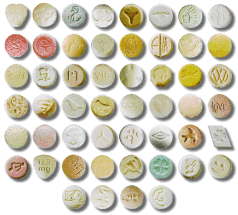Ecstasy use in the UK has exploded dramatically over the past five years, with double the number of people taking the drug. Ecstasy users are poised to overtake the combined number of heroin and cocaine users. Ecstasy use doubles in five years
Tony Thompson and Jamie Doward
A United Nations report reveals that in Britain 2.2 per cent of the population aged 16 to 59 - 730,000 people - now take ecstasy, compared with 1.2 per cent five years ago. More people take ecstasy as a proportion of the population than in any other country, except Australia and Ireland.
The report, by the UN's Office on Drugs and Crime, shows that more than 120 million tonnes of ecstasy are now produced annually. The mass production has led to a plunge in prices: an ecstasy tablet can be bought for £3.
The number of Britons taking heroin has remained rela tively static at around 300,000. Just under 500,000 use cocaine. Soon, figures suggest, ecstasy will be more popular in the UK than cocaine and heroin combined.
The report shows seizure rates for synthetic drugs such as ecstasy and amphetamine (speed) are rising by 28 per cent a year. Heroin is up by only 8 per cent and cocaine by 1.5 per cent. Globally, the number of people who consume ecstasy has soared to eight million - an increase of 70 per cent over five years. If the trend continues, global consumption of ecstasy will exceed that of heroin, now used by nine million people, within the next 12 months.
The number of people in the UK taking amphetamines has dropped from 2.6 per cent of the population five years ago to 1.6 per cent. Many of the users are believed to have switched to ecstasy.
The National Criminal Intelligence Service estimates 500,000 to two million ecstasy tablets are consumed each week in Britain. Last week, figures published in the journal Human Psychopharmacology showed there had been 72 ecstasy-related deaths in the UK in 2002, compared with 12 in 1996. Experts partly blamed the deaths on the falling costs of the drug which is often taken alongside other drugs. The report shows 40 million people worldwide take synthetic drugs such as ecstasy and amphetamine - almost twice the number who use heroin and cocaine.
'Synthetic drugs abuse begins with experimental use among mostly young people. Gradually, it may lead to dangerous polydrug use and addiction, with severe health consequences,' said Antonio Maria Costa, executive director of the UN's Office on Drugs and Crime.
The UN report shows that between 1999 and 2001 75 per cent of ecstasy laboratories seizures were in the Netherlands, 14 per cent in Belgium and 6 per cent in the UK.
Each year around 60 ecstasy factories are seized by law enforcement agencies in Europe. As they prioritise combating ecstasy production, the factories move to eastern Europe where they are less closely monitored.
Professor John Henry of Imperial College London, a leading narcotics expert, said: 'Though the use of ecstasy may continue to rise along with concerns about the drug's effect on the memory, heroin and cocaine will also be a greater concern because they have a far greater impact on society and cost the medical profession far more. What is worrying is the growth in dependence on amphetamine. We have a huge number of regular users and and a significant number of deaths, yet we rarely see them presented in medical centres.'
HOMERefs
P.L.U.R.
Ecstasy slang
Global Ecstasy
MDMA: hotlinks
MDMA: synthesis
Canadian Ecstasy
Ecstasy in the UK
Sexstasy in the UK
Accidental Ecstasy?
Ecstasy and Honesty
MDMA: Utopian Pharmacology
Buying Research Chemicals Online

